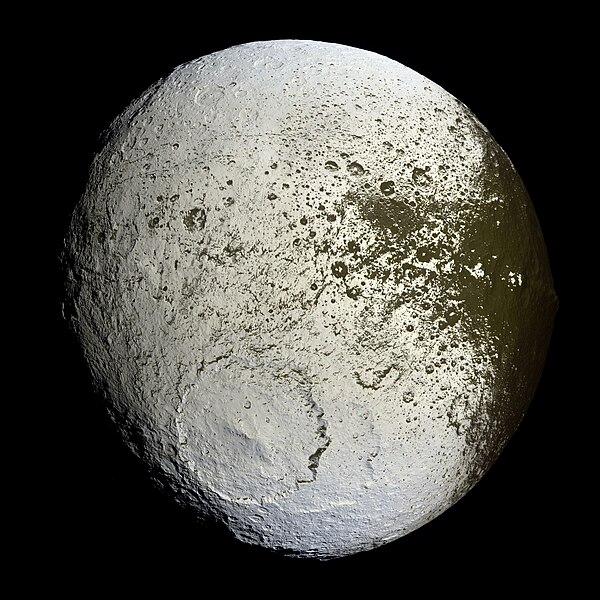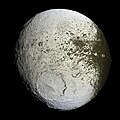Plik:Iapetus as seen by the Cassini probe - 20071008.jpg

Rozmiar podglądu – 600 × 600 pikseli. Inne rozdzielczości: 240 × 240 pikseli | 480 × 480 pikseli | 768 × 768 pikseli | 1024 × 1024 pikseli | 2048 × 2048 pikseli | 4032 × 4032 pikseli.
Rozmiar pierwotny (4032 × 4032 pikseli, rozmiar pliku: 6,22 MB, typ MIME: image/jpeg)
Historia pliku
Kliknij na datę/czas, aby zobaczyć, jak plik wyglądał w tym czasie.
| Data i czas | Miniatura | Wymiary | Użytkownik | Opis | |
|---|---|---|---|---|---|
| aktualny | 20:07, 12 gru 2018 |  | 4032 × 4032 (6,22 MB) | Kesäperuna | 100% JPEG quality from full quality TIFF, slightly cropped to be more centered. |
| 11:18, 9 paź 2007 |  | 4100 × 4100 (1,56 MB) | Startaq | {{Information |Description = Cassini captures the first high-resolution glimpse of the bright trailing hemisphere of Saturn's moon Iapetus. This false-color mosaic shows the entire hemisphere of Iapetus (1,468 kilometers, or 912 miles across) visible fro |
Lokalne wykorzystanie pliku
Następujące strony korzystają z tego pliku:
Globalne wykorzystanie pliku
Ten plik jest wykorzystywany także w innych projektach wiki:
- Wykorzystanie na af.wikipedia.org
- Wykorzystanie na an.wikipedia.org
- Wykorzystanie na ar.wikipedia.org
- Wykorzystanie na ary.wikipedia.org
- Wykorzystanie na arz.wikipedia.org
- Wykorzystanie na ast.wikipedia.org
- Wykorzystanie na az.wikipedia.org
- Wykorzystanie na ba.wikipedia.org
- Wykorzystanie na be.wikipedia.org
- Wykorzystanie na bg.wikipedia.org
- Wykorzystanie na bn.wikipedia.org
- Wykorzystanie na bn.wikibooks.org
- Wykorzystanie na bs.wikipedia.org
- Wykorzystanie na ca.wikipedia.org
- Wykorzystanie na ckb.wikipedia.org
- Wykorzystanie na cs.wikipedia.org
- Wykorzystanie na cv.wikipedia.org
- Wykorzystanie na cy.wikipedia.org
- Wykorzystanie na de.wikipedia.org
Pokaż listę globalnego wykorzystania tego pliku.




